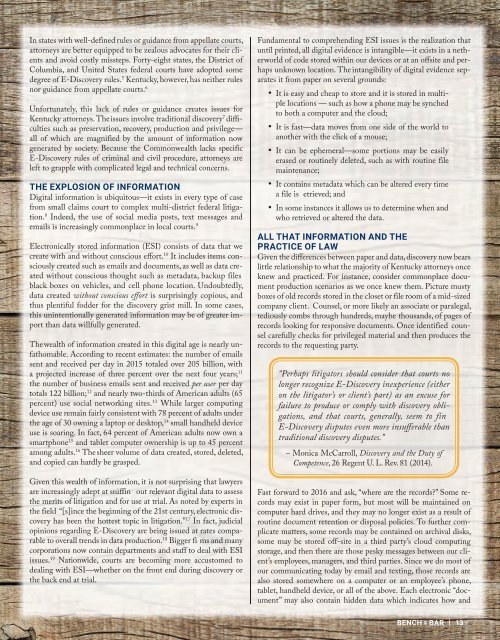you AND your spouse
BB_0716
BB_0716
You also want an ePaper? Increase the reach of your titles
YUMPU automatically turns print PDFs into web optimized ePapers that Google loves.
In states with well-defined rules or guidance from appellate courts,<br />
attorneys are better equipped to be zealous advocates for their clients<br />
and avoid costly missteps. Forty-eight states, the District of<br />
Columbia, and United States federal courts have adopted some<br />
degree of E-Discovery rules. 5 Kentucky, however, has neither rules<br />
nor guidance from appellate courts. 6<br />
Unfortunately, this lack of rules or guidance creates issues for<br />
Kentucky attorneys. Theissues involve traditional discovery 7 difficulties<br />
such as preservation, recovery, production and privilege—<br />
all of which are magnified by the amount of information now<br />
generated by society. Because the Commonwealth lacks specific<br />
E-Discovery rules of criminal and civil procedure, attorneys are<br />
left to grapple with complicated legal and technical concerns.<br />
THE EXPLOSION OF INFORMATION<br />
Digital information is ubiquitous—it exists in every type of case<br />
from small claims court to complex multi-district federal litigation.<br />
8 Indeed, the use of social media posts, text messages and<br />
emails is increasingly commonplace in local courts. 9<br />
Electronically stored information (ESI) consists of data that we<br />
create with and without conscious effort. 10 It includes items consciously<br />
created such as emails and documents, as well as data created<br />
without conscious thought such as metadata, backup files<br />
black boxes on vehicles, and cell phone location. Undoubtedly,<br />
data created without conscious effort is surprisingly copious, and<br />
thus plentiful fodder for the discovery grist mill. In some cases,<br />
this unintentionally generated information may be of greater import<br />
than data willfully generated.<br />
Thewealth of information created in this digital age is nearly unfathomable.<br />
According to recent estimates: the number of emails<br />
sent and received per day in 2015 totaled over 205 billion, with<br />
a projected increase of three percent over the next four years; 11<br />
the number of business emails sent and received per user per day<br />
totals 122 billion; 12 and nearly two-thirds of American adults (65<br />
percent) use social networking sites. 13 While larger computing<br />
device use remain fairly consistent with 78 percent of adults under<br />
the age of 30 owning a laptop or desktop, 14 small handheld device<br />
use is soaring. In fact, 64 percent of American adults now own a<br />
smartphone 15 and tablet computer ownership is up to 45 percent<br />
among adults. 16 Thesheer volume of data created, stored, deleted,<br />
and copied can hardly be grasped.<br />
Given this wealth of information, it is not surprising that lawyers<br />
are increasingly adept at sniffin out relevant digital data to assess<br />
the merits of litigation and for use at trial. As noted by experts in<br />
the field “[s]ince the beginning of the 21st century, electronic discovery<br />
has been the hottest topic in litigation.” 17 In fact, judicial<br />
opinions regarding E-Discovery are being issued at rates comparable<br />
to overall trends in data production. 18 Bigger fi ms and many<br />
corporations now contain departments and staff to deal with ESI<br />
issues. 19 Nationwide, courts are becoming more accustomed to<br />
dealing with ESI—whether on the front end during discovery or<br />
the back end at trial.<br />
Fundamental to comprehending ESI issues is the realization that<br />
until printed, all digital evidence is intangible—it exists in a netherworld<br />
of code stored within our devices or at an offsite and perhaps<br />
unknown location. Theintangibility of digital evidence separates<br />
it from paper on several grounds:<br />
• It is easy and cheap to store and it is stored in multiple<br />
locations — such as how a phone may be synched<br />
to both a computer and the cloud;<br />
• It is fast—data moves from one side of the world to<br />
another with the click of a mouse;<br />
• It can be ephemeral—some portions may be easily<br />
erased or routinely deleted, such as with routine file<br />
maintenance;<br />
• It contains metadata which can be altered every time<br />
a file is etrieved; and<br />
• In some instances it allows us to determine when and<br />
who retrieved or altered the data.<br />
ALL THAT INFORMATION <strong>AND</strong> THE<br />
PRACTICE OF LAW<br />
Given the differences between paper and data, discovery now bears<br />
little relationship to what the majority of Kentucky attorneys once<br />
knew and practiced. For instance, consider commonplace document<br />
production scenarios as we once knew them. Picture musty<br />
boxes of old records stored in the closet or file room of a mid-sized<br />
company client. Counsel, or more likely an associate or paralegal,<br />
tediously combs through hundreds, maybe thousands, of pages of<br />
records looking for responsive documents. Once identified counsel<br />
carefully checks for privileged material and then produces the<br />
records to the requesting party.<br />
“Perhaps litigators should consider that courts no<br />
longer recognize E-Discovery inexperience (either<br />
on the litigator’s or client’s part) as an excuse for<br />
failure to produce or comply with discovery obligations,<br />
and that courts, generally, seem to fin<br />
E-Discovery disputes even more insufferable than<br />
traditional discovery disputes.”<br />
– Monica McCarroll, Discovery and the Duty of<br />
Competence, 26 Regent U. L. Rev. 81 (2014).<br />
Fast forward to 2016 and ask, “where are the records?” Some records<br />
may exist in paper form, but most will be maintained on<br />
computer hard drives, and they may no longer exist as a result of<br />
routine document retention or disposal policies. To further complicate<br />
matters, some records may be contained on archival disks,<br />
some may be stored off-site in a third party’s cloud computing<br />
storage, and then there are those pesky messages between our client’s<br />
employees, managers, and third parties. Since we do most of<br />
our communicating today by email and texting, those records are<br />
also stored somewhere on a computer or an employee’s phone,<br />
tablet, handheld device, or all of the above. Each electronic “document”<br />
may also contain hidden data which indicates how and<br />
BENCH & BAR |<br />
13



